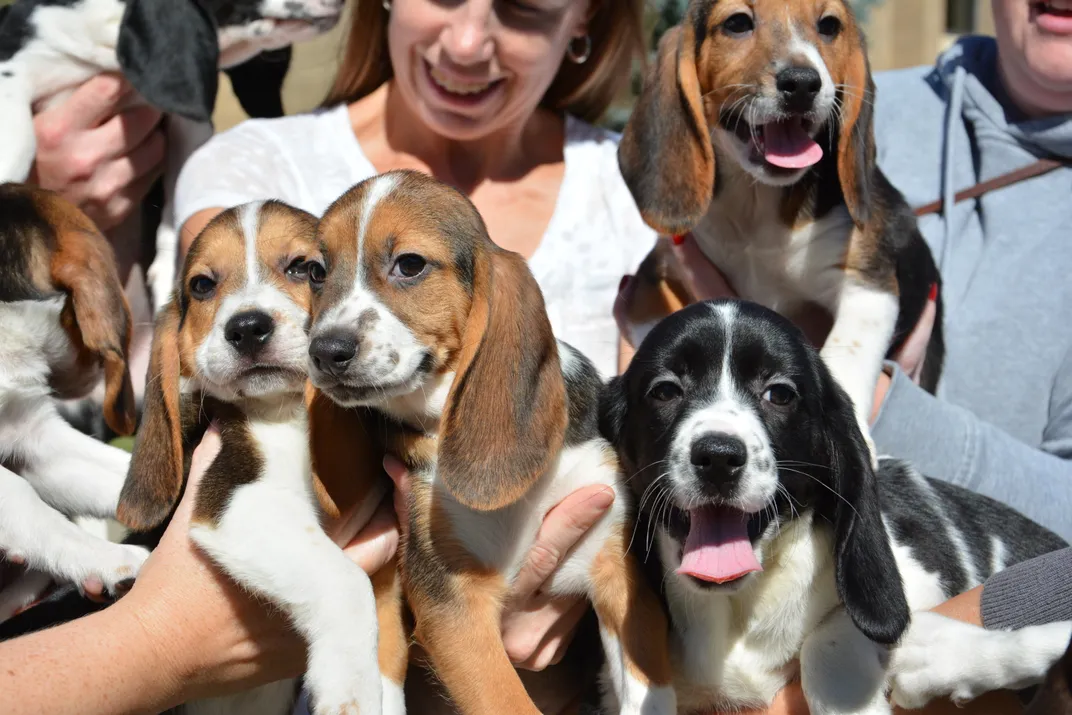These Baby Beagles Are the First Dogs Born by In Vitro Fertilization
After more than 30 years, scientists have figured out how to create healthy puppies in the lab
/https://tf-cmsv2-smithsonianmag-media.s3.amazonaws.com/filer/99/62/99629f0f-14a7-47f3-83c3-04c161df2219/cvm_ifvpuppies_2015_31.jpg)
The squirming, yipping puppies in Alexander Travis' lab don't seem like medical marvels. But these furry wonders are the first dogs born using in vitro fertilization, a process that's taken more than 30 years to develop for canines.
In vitro fertilization (IVF) is the process of fertilizing an egg with sperm in a lab. We've been doing it successfully in humans and a few other animals since the 1970s, but scientists were struggling to figure out how it works for dogs. The technique could help save endangered canine species in the wild and, in combination with gene editing techniques, may even help make domestic breeds healthier.
"People have been working on this since IVF was invented," says Travis, a reproductive biologist at Cornell University. "No one has ever made progress with IVF in the dog. This is the first success."
The trouble was partially because biologists were doing experiments based on incomplete science, in particular, a paper published in 1978 in the journal Gamete Research that suggested magnesium slowed down sperm.
Dog sperm looks similar to human sperm, but unlike the human version, dog sperm isn't ready to fertilize an egg right away. That's because dog sperm has a coating of cholesterol that covers its head, where the DNA information is kept. When sperm travels through a female dog's uterus, chemicals including magnesium break down that coating. If the coating remains intact, the sperm's DNA can't fertilize the egg.
That same bath of chemicals tells the sperm to wiggle its tail, which acts like a propeller, helping it burrow into the egg so it can deposit that DNA. With magnesium, the sperm can swim faster and more easily penetrate the egg.
During in vitro fertilization, the sperm is in a test tube and not a uterus, so scientists had to re-create the chemical bath inside the dog's body. But no other scientist thought to include magnesium because of the 1978 paper. Without it, you can put a dog sperm next to an egg and nothing will happen.
"Why not magnesium? Everyone is using this medium without questioning, and it was invented in the 1970s," says study the paper's lead author Jennifer Nagashima, a reproductive biologist in Travis' lab and a member of the Joint Graduate Training Program between the Smithsonian Conservation Biology Institute and Cornell's Atkinson Center for a Sustainable Future.
"We went back and looked at it," Nagashima says. "It's definitely a life lesson—I question everything now."

Previous researchers were also relying on the human IVF process to design the dog process, but our reproductive systems have some notable differences that weren't being taken into account. Humans ovulate about once a month—which means the ovaries release an egg that's ready for fertilization. But dogs only ovulate once or twice a year, and their eggs aren't immediately viable.
By relying on a human body's timeline to work with dogs, scientists were removing the eggs from the female dog too early. Instead, the team found that dog eggs have to sit inside their oviducts (fallopian tubes in humans) for a time before they're ready for IVF.
When Nagashima and her colleagues removed the eggs right after ovulation, none of the eggs fertilized. But when they waited four days, 80 percent of the eggs fertilized, the team reports this week in PLOS ONE.
After removing the eggs from the dog's uterus, the scientists placed them in a culture with the sperm and waited about 48 hours for the mixture to create new cells, which means it was on its way to being a dog fetus. These cells were then removed from the petri dish, frozen and later implanted in a surrogate dog.
Out of 19 fertilized embryos, seven tiny beagle-mix puppies were born on July 10—after decades of research.
"You hear those first cries, and that's a pretty good feeling," Travis says. The next step is to learn how to remove the dog eggs without doing major surgery.
By advancing IVF technology for dogs, scientists could increase populations of endangered canine species, says Margaret Root Kustritz, a small animal reproduction specialist at the University of Minnesota. Endangered canids that are unwilling or unable to procreate the usual way could serve as egg donors, thereby ensuring that their valuable genes continue on to the next generation.
IVF could also be used for reducing disease in domestic dogs. Many pure breeds today suffer from genetic disorders that could be removed using IVF and modern gene editing tools. Such research may even aid our understanding of human diseases. While chimps are closer to us genetically, we share more than 350 disease traits with dogs, which is twice as many as any other species.
"That is a huge positive step," Root Kustritz says. "Every study that helps us better understand normal reproductive biology helps us think about how we might use that knowledge to help animals and humans."

/https://tf-cmsv2-smithsonianmag-media.s3.amazonaws.com/accounts/headshot/Photo_Bloudoff.jpg)
/https://tf-cmsv2-smithsonianmag-media.s3.amazonaws.com/accounts/headshot/Photo_Bloudoff.jpg)